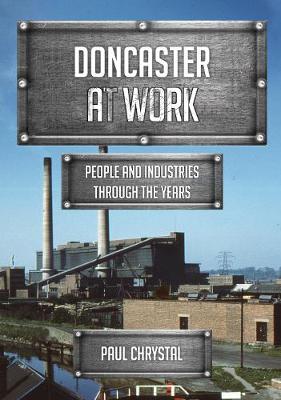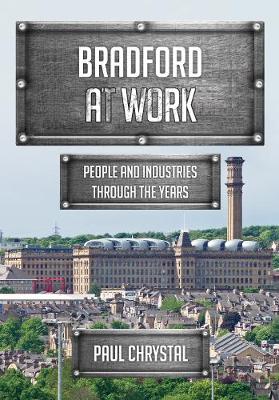At Work
3 total works
Doncaster has always benefited from its location. It stands on the Great North Road, superseded by the A1, the primary route for all traffic from London to Edinburgh, and due to its strategic geographical importance it emerged as an industrial centre in the mid-nineteenth century. Beneath the town lies a huge coal seam and it was this that prompted Doncaster's exponential population growth. In the early part of the twentieth century Doncaster became one of the largest coal mining areas in the country, with the industry becoming one of the most significant local employers.
Doncaster at Work explores the life of the town and its people, from pre-industrial beginnings through to the present day. In a fascinating series of photographs and illustrations it takes us through the rise of the coal industry and the town's role as a major railway engineering centre, the closure of several collieries in the mid-1980s and subsequent loss of many other tertiary industries, and into the twenty-first century as the town's fortunes have changed with the redevelopment and rejuvenation of its centre.
Doncaster at Work explores the life of the town and its people, from pre-industrial beginnings through to the present day. In a fascinating series of photographs and illustrations it takes us through the rise of the coal industry and the town's role as a major railway engineering centre, the closure of several collieries in the mid-1980s and subsequent loss of many other tertiary industries, and into the twenty-first century as the town's fortunes have changed with the redevelopment and rejuvenation of its centre.
Bradford is rightly proud of its industrial heritage. This West Yorkshire city rose to prominence during the nineteenth century as an international centre of textile manufacturing, particularly worsted. It was a boomtown of the Industrial Revolution, becoming known worldwide as 'Worstedopolis'. The area's access to a supply of coal, iron ore and soft water facilitated the growth of Bradford's manufacturing base, which, as textile manufacturing grew, led to an explosion in population.
Bradford at Work explores the life of the city and its people, from pre-industrial beginnings through to the present day. In a fascinating series of photographs and illustrations it takes us from the city's early days as a major steel town and then a growing centre of the wool trade, through the Industrial Revolution, the traumas of the war years, post-war industrial decline and into the technologically advanced world of today. It shows how Bradford has transformed itself from a textile town into a centre of education and innovation, as well as a burgeoining tourist destination, becoming the first UNESCO City of Film with attractions such as the National Media Museum, Bradford City Park, and the Alhambra Theatre. The book also covers industry in neighbouring Saltaire and Shipley, chapters on the often forgotten local cotton industry, the industrial village of Ripley Ville and Leeds Bradford Airport.
Bradford at Work explores the life of the city and its people, from pre-industrial beginnings through to the present day. In a fascinating series of photographs and illustrations it takes us from the city's early days as a major steel town and then a growing centre of the wool trade, through the Industrial Revolution, the traumas of the war years, post-war industrial decline and into the technologically advanced world of today. It shows how Bradford has transformed itself from a textile town into a centre of education and innovation, as well as a burgeoining tourist destination, becoming the first UNESCO City of Film with attractions such as the National Media Museum, Bradford City Park, and the Alhambra Theatre. The book also covers industry in neighbouring Saltaire and Shipley, chapters on the often forgotten local cotton industry, the industrial village of Ripley Ville and Leeds Bradford Airport.
Despite its remote location, surrounded by the high ground of the North York Moors, Whitby has featured significantly in history throughout the years. One of the earliest records of Whitby is from AD 656, when Oswy, a Christian king of Northumbria, founded the first abbey there. In AD 664, the town was the setting for the famous Synod of Whitby.
It was the town’s coastal location that would ensure its success as it grew to become a major fishing port and an important base for the whaling industry. The town’s jet jewellery industry flourished in the second half of the nineteenth century after Queen Victoria made the famous black gemstone fashionable as a mourning accessory.
Whitby has been a popular tourist destination ever since the Victorian period and today continues as a major attraction, helped in no small part by its associations with Dracula and the hugely popular Goth Weekend, when people come from far and wide to pay homage.
Whitby at Work explores the life of this picturesque Yorkshire coastal town and its people, from pre-industrial beginnings through to the present day, in a fascinating series of photographs and and informative text.
It was the town’s coastal location that would ensure its success as it grew to become a major fishing port and an important base for the whaling industry. The town’s jet jewellery industry flourished in the second half of the nineteenth century after Queen Victoria made the famous black gemstone fashionable as a mourning accessory.
Whitby has been a popular tourist destination ever since the Victorian period and today continues as a major attraction, helped in no small part by its associations with Dracula and the hugely popular Goth Weekend, when people come from far and wide to pay homage.
Whitby at Work explores the life of this picturesque Yorkshire coastal town and its people, from pre-industrial beginnings through to the present day, in a fascinating series of photographs and and informative text.


